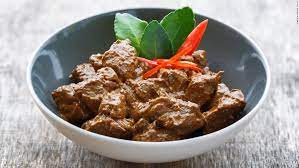(CNN) : As the world’s largest archipelagic nation, Indonesia is filled with different cultures and influences spread out over 1,904,569 square kilometers (735,358 square miles).
This makes it a huge challenge to try to summarize the flavors of the country in just a few paragraphs.
“Indonesian food culture is based on regional cooking among 17,500 islands, 38 provinces and 700 dialects,” says Indonesian cookbook author William Wongso.
“Flavors of Indonesia are very diverse. From Aceh (the westernmost province of Indonesia) to West Sumatra (also a western province), it’s only about a 1.5-hour flight, yet their food and taste profiles are totally different.”
The 75-year-old author of “Flavors of Indonesia: William Wongso’s Culinary Wonders.” says that even though he’s been traveling and eating around Indonesia for decades, he still hasn’t tasted every local dish.
For instance, chefs in the Moluccas in the eastern side of Indonesia, once nicknamed the “Spice Islands,” prefer using fresh spices like cloves, nutmeg and cinnamon. Aceh, on the other hand, frequently incorporates dried spices thanks to the influence of India, Arabia and China.
Padang (or Minangkabau) cuisine in West Sumatra uses lots of coconut cream, chiles, shallots and some curry spices, as well as ginger and galangal with aromatic herbs such as turmeric leaves, kaffir lime leaves and lemon grass.
Javanese are experts in using the three colored spice pastes — red (made of chiles, shallots and garlic), white (candle nuts, shallots and garlic) and yellow (candlenuts, shallots, garlic and turmeric).
Beef rendang
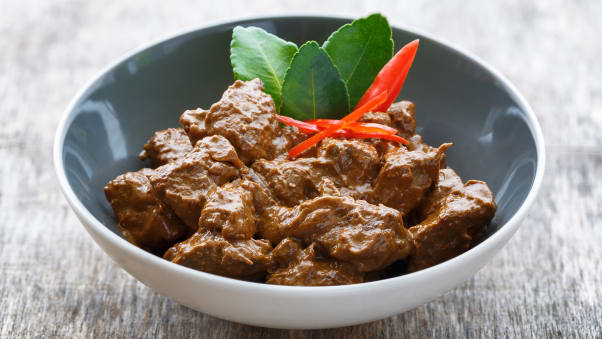
It isn’t an exaggeration to say that beef rendang is one of the world’s most flavorful foods.
A dry curry dish linked to the Minangkabau ethnic group, which is indigenous to West Sumatra, rendang is a great way to preserve meat — essential for the Minangkabau people during their travels.
There is no one recipe for rendang. “In West Sumatra, there are about 900 districts and each has their own style of rendang,” says Wongso.
But one of the most common meats to appear in rendang is beef. It’s stewed in coconut milks and spices including lemongrass, galangal, garlic, turmeric, ginger and chiles for hours until the meat is unbelievably tender and the curry mixture is reduced to a relatively dry coating around the meat.
Tempeh
A rising star in plant-based diets around the world, tempeh has in fact been a constant in Javanese culture for more than four centuries.
Even Google dedicated a day to tempeh in October 2022.
The low-fat, high-protein meat substitute is made of soybeans fermented in banana leaves — and sometimes, other leaves — for two to three days before it turns into a white moldy and chunky block.
Its flavor is often described as nutty and mushroom-y with a slight sweet soy scent.
It can be cooked the same way as any meat — baked, fried, grilled or boiled into different dishes. In Indonesia, it’s often deep-fried and served as a tasty snack.
Satay
A staple at Southeast Asian restaurants around the world, satay — or sate in the local tongue — is said to have originated in Java.
Preparation of these skewers varies from region to region, often featuring different meats or vegetables, spices, sauces and marinades.
One of the most loved versions in Indonesia is satay chicken served with a sweet peanut sauce that has just a hint of spice.
Nasi goreng
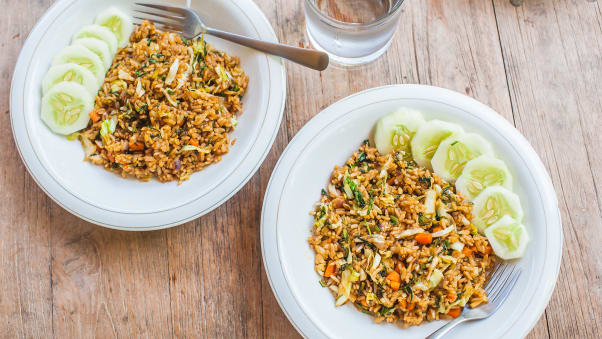
If there’s one staple that represents Indonesia’s multi-faceted culture, it’s nasi goreng — literally translated as fried rice.
Each household has a different recipe made with various ingredients and sides, but the use of terasi (shrimp paste) and kecap manis (a sweet and thick Indonesian soy sauce) unite most — if not all — versions.
These condiments create Indonesian fried rice’s unique taste.
Topped with a perfect sunny-side-up egg and a side of crunchy shrimp crackers (or kerupuk), nasi goreng is a versatile meal consumed throughout the day.
A dish influenced by Chinese cooking, nasi goreng is as popular in Singapore and Malaysia as it is in Indonesia.
Kerupuk
While prawn crackers are commonly found in several countries’ diets — especially in Indonesia and Malaysia — it was thanks to Indonesia that the snack was introduced to the Dutch and then brought to Europe.
Arguably the best sidekick to any dish, a piece of kerupuk can also serve as an edible spoon to scope up extra sauce or sambal.
Indonesian kerupuk is also used as a topping for soto — a type of Indonesian soup. (See below)
Soto Ayam
Similar to many other dishes in Indonesia, soto, or soup, tastes different depending on which part of the archipelago you are in.
One of the most commonly featured soto on Indonesian menus is the comforting soto ayam (chicken soup) — but that too, comes in countless variations.
Among all the chicken sotos, the ones from East Java — such as soto ayam Madura or Ambengan — are some of the most popular. They have a clear broth and include a generous amount of garlic, shallots, turmeric and chunks of chicken meat.
Koya powder, a unique mix of grounded prawn crackers and fried garlic, is sometimes added to give the already-rich soup — such as soto ayam Lamongan — an extra umami boost.
Gado gado
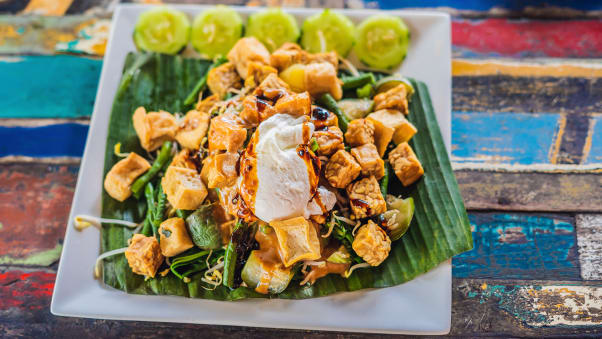
Chop up blanched vegetables, hard-boiled eggs and add a ladle of peanut sauce and you have the humble but tasty Indonesian national salad — gado gado.
A classic Indonesian peanut sauce for gado gado is made with ground roasted peanuts, chiles, shrimp paste, tamarind pulp or juice and some sugar and salt.
Translated as mix mix, this ubiquitous salad dish sometimes includes slices of fried tofu or tempeh as well as deep fried fish cakes.
Sambal
Sambal may not be one of Indonesia’s five official national dishes — alongside nasi goreng, rendang, soto, sate and gado gado — but no meal is complete without it for many Indonesians.
It’s a relish made by mixing chile peppers with a host of different ingredients such as shrimp paste, sugar, salt and lime juice.
Today, you can find it in many renowned Indonesian dishes — from nasi goreng to gado gado.
Legend has it that Portuguese and Spanish sailors brought a variant of chile peppers to Indonesia — but it was in Java that they were first pounded into sambals.
It’s believed there are more than 100 styles of sambal served across Indonesia. One of the most common is sambal terasi, which is made with chile peppers, garlic, tomatoes, shrimp paste, limes, salt and sugar.
Indomie
Not technically a dish but it might just be the country’s most famous food brand.
Wowing the market since 1972, Indomie’s flavorful and convenient packaged noodles have amassed a huge following worldwide.
It’s often ranked as the most beloved brand in Indonesia and voted as one of the best instant noodles in the world by international media.
If you’re an Indomie newbie, start with a packet of Indomie mi goreng (barbecue chicken) and you’ll likely be converted as well.
Jamu
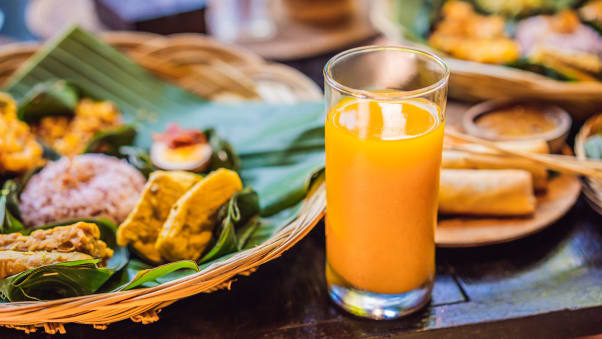
When Indonesian President Joko Widodo was asked about the secret to his good health during the Covid-19 pandemic, he cited jamu.
A traditional Indonesian herbal drink made from various combinations of plants and spices — ginger and turmeric are two common ingredients — jamu is believed to boost one’s immune system.
There are many ways to make jamu.
Widodo’s recipe, which he shared on his Instagram account back in 2019, is made with temulawak (Javanese ginger) among other ingredients.
The plants and spices are blended into a concentrated juice and it’s often served warm.
The president also said that he has been drinking it daily for the last two decades and boosted his daily jamu consumption to three times per day during the pandemic.
In recent years, jamu-inspired juice brands have been popping up around the world.
Babi guling
There are a few things that make us dream of Bali — the pristine beaches, the endless rice fields and, for some, babi guling, the vacation island’s famed roasted suckling pig.
The animal is rubbed with turmeric and stuffed with a spice paste made up of coriander seeds, lemongrass, Asian lime and salam leaves, chilies, black pepper, garlic, red shallots, ginger and kencur. Then, it’s roasted on a spit.
Every part of the pig — meat for satay, juicy pork slices, crispy crackling as well as the richly flavored intestines — will be enjoyed.
It’s mostly served with rice, spicy soup and a series of condiments.
The dish is rarely seen in the rest of Indonesia, where a majority of the population is Muslim and considers pork consumption haram, or forbidden. On Bali, most people identify as Hindu.
Rijsttafel
And lastly, one can’t forget about rijsttafel, or rice table, in Dutch.
It’s an elaborate spread of small Indonesian plates featuring different tastes and levels of spiciness in one meal.
Rijsttafel is technically not part of traditional Indonesian food culture. It was first introduced during Dutch colonial rule in Indonesia, when the Europeans would serve small plates of sumptuous Indonesian dishes — from sweet to spicy — to their visitors.
It’s still a common offering at Indonesia restaurants in the Netherlands as well as in its country of origin.
According to Wongso, rijsttafel culture is one of the reasons many traditional Indonesian dishes grew popular outside of Asia.

